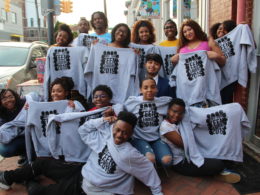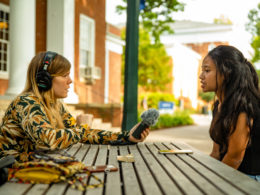Not long after the earliest incarnation of the United Way of Greater Richmond & Petersburg first set about helping some of the community’s most vulnerable populations, the world changed. The Spanish flu of 1918 swept over the city that fall, eventually infecting more than 10% of the population. While the Red Cross worked closely with the State Board of Health and other organizations on organizing a response, the nascent United Way aimed its work on what would become its focus over the century to come – empowering individuals and putting in place systems of support that give them the best chance to live healthy, productive lives.

Fast forward 100-plus years later, and Central Virginia’s local United Way continues to carry out its mission. Today, its work encompasses the cities of Richmond, Petersburg and Colonial Heights and the eight counties that surround them. A century after the last pandemic, how has COVID-19 affected one of the Richmond area’s most influential and effective nonprofits? We talked with United Way of Greater Richmond & Petersburg’s president and CEO, James Taylor, to find out.
Let’s start from a practical, logistical standpoint. When you consider how much of your giving platforms are tied into physical workplaces, how has the pandemic affected your capacity to fundraise?
The adjustments we’ve made associated with the pandemic have been meaningful for us. You’re right, so much of our fundraising work traditionally has been within a workplace setting, by group meetings and presentations. But we’ve adapted by using electronic tools, and we’ve gotten way better at Zoom than we ever thought we needed to be – and not just for group presentations but using technology for follow-ups and growing individual relationships. That’s been somewhat of a silver lining to all this.

Beyond the workplace campaigns, our other work has been able to move forward reasonably well. We’re marketing in new ways, experimenting with video communications, for example. Our community work has expanded and become more effective in some areas. Some of our partnerships have gotten deeper. But generally speaking, the pandemic has not overwhelmingly impacted the ability to carry out our work. A lot of our folks are working remotely, but we never closed, and we continue to carry out the core elements of our operations.
We did an end-of-year piece last December on how local nonprofits responded to a new fundraising environment, and many told us that their core donors really stepped up during the crisis. Was that the case for you?
It was. Our donor base is generally more of a shifting base because of the large number of donors and workplace churn. But we’ve seen large numbers of people we’ve had in the past continue to find ways to give. Our major donors and our leadership donors also have come through in very solid ways. The bigger issue relates to the folks that would be working but aren’t – that’s where we’ve seen some understandable falloff in giving as well as increased need for assistance. But we’ve also seen some new donors, folks who are stepping up saying, “This may be the time for me to do something that I might not have done in the past, but I know people are hurting more than I am, and this is a great way to give since I don’t have to do it all at once.” People are realizing they can make a bigger impact by doing $5 a week as opposed to cutting a check for $250, which they might not be able to do.
What about your relationships with your agency partners? Has the pandemic had an impact on that front?
We have worked hard to maintain communications with our funded partners. Other than one organization that closed, all of our partners have been able to maintain their operations and are doing things in new and different ways. And we’ve seen some creative efforts. Friends Association, for example, shifted its model and has been working with a different population because of the way the world changed last March.

We’ve seen organizations struggling in different ways. If you’re an adult day center, you’re already dealing with a population that in and of itself is at greater risk. And now, when you’re doing that in a congregate setting, you expose clients to different levels of risks that they might not have otherwise had. And so we’ve worked closely with some of those organizations to understand where they are, and they continue to operate with a level of diligence that is particularly admirable.
The world changed radically in March when the governor basically locked everything down. If you’re an organization that relies on Medicaid reimbursement for what you’re doing, and you can’t get reimbursements because you can’t provide people your services because you’re locked down, you have a cash crunch in a hurry. We have not been asked for additional resources or even for an accelerated disbursement. But we’ve tried to be supportive, even in just an advisory capacity.
There are so many lessons coming out of the pandemic. What has it taught you about United Way’s role in supporting local communities?
When you consider that state governments and state leaders were devising strategy, it was left to local jurisdictions to do the implementation, and so our understanding of the nature of each of the 11 jurisdictions we serve was particularly important, and the pandemic underscored our appreciation for that. If you’re in a highly concentrated environment, like the City of Richmond and to some extent in Petersburg, it’s a different environment completely than if you’re talking about Dinwiddie or Charles City where populations are very dispersed. You have different logistical challenges of how you provide basic needs, and our support turned out to be much more critical.
The pandemic itself is a public health crisis and it exposed our needs for healthcare, but at the same time, it also reminded us of this massive need for food assistance, for rental housing assistance, for energy assistance, those kinds of things. And while we saw great generosity from a number of different organizations, including Dominion and the governor around ending shutoffs for a long period of time, it didn’t stop the amassing of the debt that many individuals were having. And so, working in that space was important.

Beyond that, we really saw the need for neighborhoods, for people on the street to look out for one another, perhaps more than they had before. Social isolation is something we’ve talked about for many years as a problem in the senior population. Yet, everybody is now forced to be socially isolated to some extent. That’s creating its own set of issues for everyone, and it becomes clearer that seniors are at greater risk. It’s important for people to help one another, and proximity became an important part of community.
Has the pandemic changed your priorities? Your Steps to Success are so interconnected and build on one another. It makes us think that those building blocks aren’t likely to change even during times like these.
I think you nailed it with the sense that they’re the building blocks. All of those things fit together, but we’ve seen a prioritization across the community around basic needs. And that is part of the framework. Without basic needs, it’s really hard to focus on other issues. Making sure you have food and shelter, all those things. Then you have to figure out is kindergarten going to be virtual or in person? Is it going to be safe for my children? All of those decisions were significantly challenging to families, and we wanted to be sure we were providing stability in that space.
When you think about Steps for Success as a critical building block for how you have success, the basic needs provision has clearly moved into preeminence with the economic impacts associated with it. There are people who have lived very close to the margin for many years, and we know from looking at the data that it’s not an equal impact across race and ethnicity. So, you’ve got a whole set of issues to deal with in terms of how you find ways to access those basic needs in a meaningful way so that we can then support them along with the rest of the steps.
Would you characterize what’s going on as far as fulfilling basic needs as being at a crisis level? Do you think the need has peaked? How would you characterize where we are?
I think the worst scenario was prior to reopening. We’ve seen the unemployment numbers come back down pretty dramatically. That’s an encouraging sign. What we also know is that people who had savings used it. People who relied on public assistance used it, whether it’s utility or rental assistance. I would say that as a region, the safe normalization of activity can’t happen fast enough, and that normalization needs to include the opportunity for folks to not only regain the wages they had but find ways to regain whatever savings they had before. There’s got to be a level of recovery that allows for wage growth for low-income workers so that they can live less close to the margin than they did before. And there has to be a recovery that provides ample employment so that folks that have been on the sidelines, even before the pandemic, have the opportunity to get back into the workforce.
Given the way that you’ve adapted, the way you’ve responded to challenges, what do you think will last? It’s not as if you will go back to the way you used to do things without some changes moving forward. What are the things you’ve found you could do differently that you see continuing?
I think we’re going to see greater use of virtual meetings, greater use of virtual program delivery. And we’re probably going to see a greater level of that kind of one-on-one fundraising that I talked about. I expect that office space will start to shrink. We’ll see an embrace of virtual learning. There will likely be more virtual work opportunities, at least part of the week if not five days a week. That means less of a footprint, which from a workplace campaign standpoint means virtual campaigns and electronic interface is going to be that much more important.
From a program delivery standpoint, we’re doing to see more virtual solutions. We turned our Kindergarten Countdown Camp in Dinwiddie into a virtual format this year, and it was very successful. Now we have to ask how to address challenges further along the steps. How do you do third grade reading if people are virtual? How do you manage that?
There’s some real resilience in some of these nonprofits. We will see some contraction in the nonprofit space just as we’ve seen in the restaurant industry, but the nonprofits that are going to survive will come out of this with a level of effectiveness by doing things very differently but with the ability to go back to what they’ve done in the past. So, we’ll see some of that happening. For us, it’s going to mean looking at costs associated with program delivery and understanding the value of in-person vs. virtual. How will this be applied in a mixed model, whether it’s for early childhood education, support for students in middle grades, etc. Those kinds of things we’re going to have to determine, and there’s an opportunity for us to think about all that.
When you think about how you and your team responded over the past year, what are the moments that come to mind that you’re particularly proud of?
There are a lot of proud moments. The first one that comes to mind is how we got aligned and appropriately engage with the COVID-19 Response Fund. It was a really good thing for us to be part of. There was some suggestion that we do something different or work with a different group of partners, so it was a muddy moment for a time. But we got through that, and it was important to find the right answer. Partnering with the Community Foundation, PlanRVA and the broader effort, that was absolutely the right approach for us, and our team did an effective job, particularly our marketing folks who we relied on heavily for a lot of technical expertise and for getting messages out appropriately and broadly.

We had some good moments working with Kym Grinnage and the group at NBC-12. What a great team in terms of getting the word out there; just some real energy there. Of course, the entire media partnerships were out there working on these issues, so that was a high watermark to see our role in that make such a big difference to so many different organizations.
I’d also have to cite the group of folks who kept the organization running. For 16 or so weeks, we had no one really in the office except for a core group of essential folks, and they just kept things chugging, making sure things were happening. That was something, and I was so proud of that. We also moved our offices last fall after 15 years in the same location. We were able to get to a smaller, more efficient space with better signage, more visibility. I was very proud of our team making that happen and doing so at a cost savings which was just icing on the cake.
And overall, I’m proud that we’ve really kept things working. Our grantees have continued to receive their funding on time, to have sustainable funding. We’re now in the second year of a three-year grant cycle, and there’s been no changes with the exception the organization that closed. We’ve been able to provide the support that folks have always looked to us for, and we’ve done so I think with a great deal of effectiveness.
As you start to look past the pandemic, what do you see as your goals for the year ahead?
Our goal for 2021 is to continue to be engaged in working with communities, to empower people so that they can address their own needs most effectively. That’s been a major part of our four-layer cake approach, but we recognize in this environment, it’s absolutely critical to do that.
One of the things that United Way stands for is bringing people together, and we’re in a very polarized time. We think it’s pretty important for us to stand up and talk about the things that we actually agree on. The vast majority of people want their kids born healthy. Most people want their kids entering kindergarten ready to succeed. That makes sense. How do we get people focused on the things we all can agree on, in ways that allow for communication? The absence of communication with people who think differently from us creates the ability to call them the “other.” And when you do that, you can make them whatever you want them to be. They can be as awful as you want them to be. That’s how you wind up with the situation we have. If we can find ways to think about our community, not simply virtually but personally as people, it makes a big difference. How do you help people understand what is actually happening, and what people have in common? There are folks in Southwest Virginia where I grew up that are struggling with some of the very same problems that folks in the East End of Richmond are having. They see the world very differently, but they share a great deal.
If you haven’t already, consider donating to the United Way of Greater Richmond & Petersburg, and follow the organization on Facebook and Twitter.
At the date of publication, this organization is a client of The Hodges Partnership.










